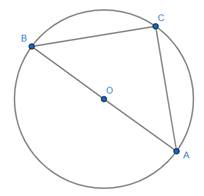AB is a diameter of a circle and C is any point on the circle. Show that the area of Δ ABC is maximum, when it is isosceles.
Given: a circle with AB as diameter and C is any point on the circle
To show: area of Δ ABC is maximum, when it is isosceles
Explanation: Let r be the radius of the circle, then the diameter will be
AB = 2r

Now we know, any angle in the semi-circle is always 90°.
Hence ∠ACB = 90°
Now let AC = x and BC = y
Then by applying the Pythagoras theorem to the right-angled triangle ABC, we get
(2r)2 = x2+y2
⇒ y2 = 4r2-x2
![]()
Now we know area of ΔABC is
![]()
Now substituting value from equation (i), we get
![]()
Now we will find the first derivative of the area, we get

Applying the product rule of differentiation and taking out the constant terms, we get

Applying the power rule of differentiation, we get

![]()




Now to find the critical point we will equate the first derivative to 0, i.e.,
A’ = 0

⇒ 2r2-x2 = 0
⇒2r2 = x2
![]()

![]()
Or
![]()
Now we know, r≠0
Hence ![]() and x = r√2
and x = r√2
Now we will find the second derivative of the area equation, this can be done by again differentiating equation (iii), we get


Taking out the constant terms and applying the product rule of differentiation, we get

Applying the power rule of differentiation, we get
![]()
![]()
![]()



For ![]() in above equation, we get
in above equation, we get




Hence for ![]() , the area of ΔABC is maximum
, the area of ΔABC is maximum
Now we will find the maximum value by substituting ![]() in equation (i), we get
in equation (i), we get
![]()
![]()
![]()
⇒ y = r√2 = x
i.e., the two sides of the ΔABC are equal
Hence the area of Δ ABC is maximum, when it is isosceles
Hence proved